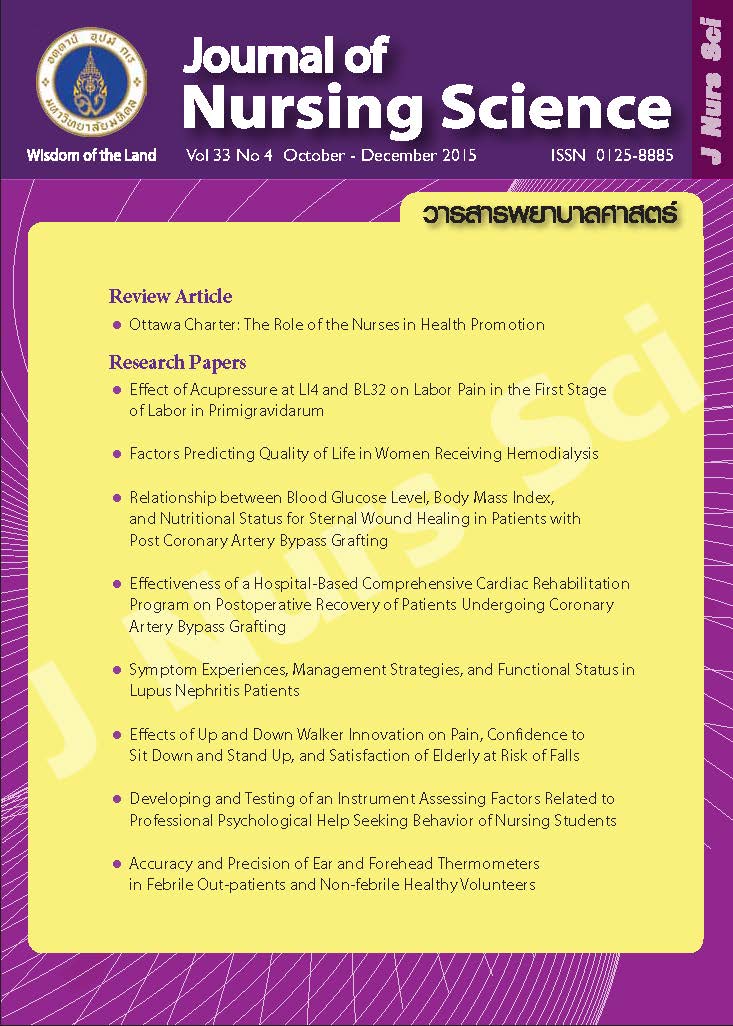Effects of Up and Down Walker Innovation on Pain, Confidence to Sit Down and Stand Up, and Satisfaction of Elderly at Risk of Falls
Main Article Content
Abstract
Purpose: This quasi-experimental research aimed to: 1) compare the level of knee pain in elderly before and after using the innovation; 2) compare the confidence of elderly to sit down and stand up before and after using the innovation; and 3) explore satisfaction of elderly in using the innovation.
Design: One-group pre-test post-test design.
Methods: Samples were 30 elderly aged between 60-90 years old from an elderly club of Nantana Garden Village, Nonthaburi province. Up and Down Walker was adapted from a normal walker. Its height can be adjusted to suit the position of elderly and those with knee problems. Measures were composed of pain scale, modified falls efficacy scale, and satisfaction scale. Data were analyzed using descriptive statistics and paired t-test.
Main findings: The majority of samples were females (93.33%), age average 70.27 years (Range 87-60). 30.00% had Osteoarthritis of knee and 60.00% had knee pain. 17.06 minutes were used for Time Up And Go test. After using Up and Down Walker, samples had significantly decreased pain during sitting down on a chair and standing up (t = 4.097, df = 29, p < .05) compared to those measured before using the innovation. The confidence of elderly to sit down and stand up was non-significantly increased (p > .05). Samples had very high level of satisfaction in using Up and Down Walker.
Conclusion and recommendations: Up and down walker can relieve the elderly’s knee pain during sitting and standing and increased satisfaction of those who used it. It is recommended for elderly who need walker in their daily living and should use continuously at least one week to see the effectiveness.
ประสิทธิผลของนวัตกรรมอัพแอนด์ดาวน์วอล์คเกอร์ ต่ออาการปวดข้อเข่า ความมั่นใจเมื่อลุก-นั่ง และความพึงพอใจของผู้สูงอายุที่มีความเสี่ยงต่อการหกล้ม
บทคัดย่อ
วัตถุประสงค์: งานวิจัยนี้มีวัตถุประสงค์เพื่อ 1) เปรียบเทียบอาการปวดข้อเข่าของผู้สูงอายุก่อนและหลังใช้นวัตกรรม 2) เปรียบเทียบความมั่นใจในการลุก-นั่งของผู้สูงอายุก่อนและหลังใช้นวัตกรรม และ3) ประเมินความพึงพอใจของผู้สูงอายุหลังใช้นวัตกรรม
รูปแบบการวิจัย: การวิจัยแบบ One-group pre-test post-test design
วิธีดำเนินการวิจัย: อาสาสมัครจำนวน 30 คน ที่มีอายุระหว่าง 60-90 ปี จากชมรมผู้สูงอายุหมู่บ้าน นันทนาการ์เด้น จังหวัดนนทบุรี โดยนวัตกรรม Up and Down Walker ดัดแปลงมาจาก Walker ที่มีจำหน่ายในท้องตลาด ทำให้สามารถปรับระดับได้เมื่อใช้ในการลุก-นั่งเก้าอี้ของผู้สูงอายุ เก็บรวบรวมข้อมูลโดยใช้แบบวัด 3 แบบ ประกอบด้วยแบบประเมินอาการปวดข้อเข่า แบบประเมินความมั่นใจในการลุก-นั้ง และแบบวัดความพึงพอใจ วิเคราะห์ข้อมูลด้วยสถิติเชิงพรรณนา และ Paired t-test
ผลการวิจัย: กลุ่มตัวอย่างส่วนใหญ่ร้อยละ 93.33 เป็นเพศหญิง อายุเฉลี่ย 70.27 ปี (พิสัย
60-87 ปี) ร้อยละ 30 มีโรคข้อเข่าเสื่อม และร้อยละ 60 มีอาการปวดข้อเข่า ผลการทดสอบ Time Up and Go มีการใช้เวลาเฉลี่ย 17.06 นาที หลังใช้นวัตกรรมกลุ่มตัวอย่างมีคะแนนอาการปวดลดลงเทียบกับก่อนใช้อย่างมีนัยสำคัญทางสถิติ (t = 4.097, df = 29, p < .05) คะแนนความมั่นใจในการลุก-นั่งเปรียบเทียบระหว่างก่อนและหลังการใช้นวัตกรรมไม่แตกต่างกันอย่างมีนัยสำคัญทางสถิติ (p > .05) และกลุ่มตัวอย่างมีความพึงพอใจในระดับสูงมาก
สรุปและข้อเสนอแนะ: Up and down walker เป็นนวัตกรรมที่ช่วยให้ผู้สูงอายุลดอาการปวดข้อเข่าและมีความมั่นใจในการลุก-นั้ง มากนึ้ ในการใช้นวัตกรรมนี้ควรเลือกผู้สูงอายุที่มีความจำเป็นในการใช้อุปกรณ์ช่วยพยุงในชีวิตประจำวัน และ ควรใช้อุปกรณ์ต่องเนื่องอย่างน้อย 1 สัปดาห์ เพื่อจะได้เห็นผลการเปลี่ยนแปลงที่ชัดเจน
คำสำคัญ: ผู้สูงอายุ การหกล้ม การทรงตัว ความมั่นใจ อาการปวดเข่า ความพึงพอใจ
Article Details
Copyright Notice: Nursing Science Journal of Thailand has exclusive rights to publish and distribute the manuscript and all contents therein. Without the journal’s permission, the dissemination of the manuscript in another journal or online, and the reproduction of the manuscript for non-educational purpose are prohibited.

Disclaimer: The opinion expressed and figures provided in this journal, NSJT, are the sole responsibility of the authors. The editorial board bears no responsibility in this regard.


